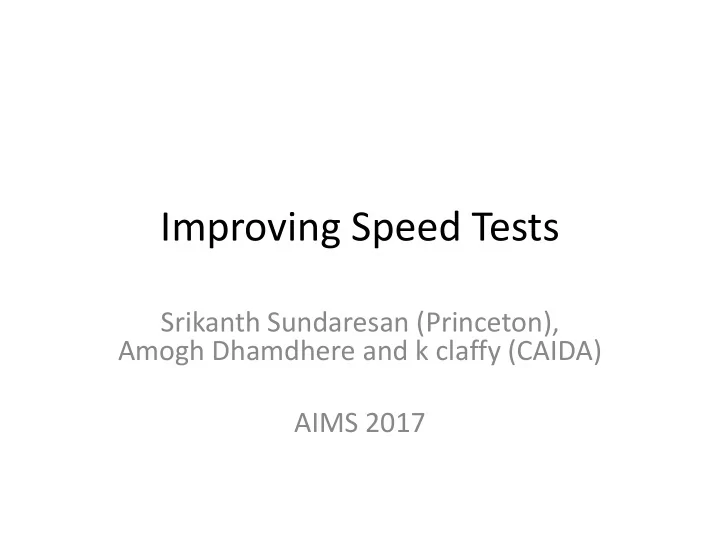

Improving Speed Tests Srikanth Sundaresan (Princeton), Amogh Dhamdhere and k claffy (CAIDA) AIMS 2017
Speed tests have not changed in years • They still just run TCP stream(s) between two hosts and report a number • None of the popular tools try to do anything more – No attempt at any type of diagnosis • Where did congestion occur (if it occurred)? • Was it the access link or the wireless link or something else?
Very little needs to change to be able to answer (some of) these questions • Packet captures at servers can tell us about RTT – Which in turn can tell us about the conditions that the flow encounters • The TCP flow has already punched a hole in the NAT – Which ought to let us probe the path all the way to the end host
Very little needs to change to be able to answer (some of) these questions • Packet captures at servers can tell us about RTT – Which in turn can tell us about the conditions that the flow encounters • The TCP flow has already punched a hole in the NAT – Which ought to let us probe the path all the way to the end host
What sort of congestion did a TCP flow encounter? • Self-induced congestion? – Clear path, the flow itself induced congestion – Access links with plan rates • Already congested path? – Low available capacity – Congested interconnect • Cannot distinguish using just throughput numbers – Plan rates vary widely
TCP Congestion Signatures • Self-induced congestion fills up an empty buffer during slow start – This causes the RTT to increase (Max RTT – Min RTT) – Also increases variability (Coeff. Of Variation of RTT) • Simple Decision Tree Model Using the RTT Parameters
Does it work? • Extensive validation using controlled experiments testbed – Build model using Max – Min RTT testbed data – Minimize complexity CoV of RTT
“Validation” using M -Lab data • Time-span – Cogent interconnection issue (~Feb 2014) – Coarse ground truth – The two event periods clearly stand out
Very little needs to change to be able to answer (some of) these questions • Packet captures at servers can tell us about RTT – Which in turn can tell us about the conditions that the flow encounters • The TCP flow has already punched a hole in the NAT – Which ought to let us probe the path all the way to the end host
Very little needs to change to be able to answer (some of) these questions • Packet captures at servers can tell us about RTT – Which in turn can tell us about the conditions that the flow encounters • The TCP flow has already punched a hole in the NAT – Which ought to let us probe the path all the way to the end host
Probing the TCP Path Using BufferTrace • The Idea: Send TTL-limited packets within a TCP flow – Observe the buildup of buffers – Trace the path that the flow actually takes – Send zero-payload TCP packets so as to not break the application layer – Encode hop ID in the sequence number • Some NATs rewrite the IPID field
Demo https://github.com/ssundaresan/buffertrace [Private repo, ping me for access] Based on: https://github.com/robertswiecki/intrace
Drawbacks • Both techniques depend on buffering – How much? • Lack of solid ground truth for congestion signatures – Any labeled data source for interconnect congestion? srikanths@princeton.edu
Recommend
More recommend